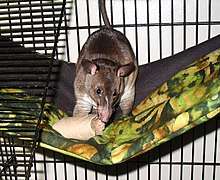Giant pouched rat
The giant pouched rats (genus Cricetomys) of sub-Saharan Africa are large muroid rodents. Their head and body lengths range from 25–45 cm (10–17.5 in) with scaly tails ranging from 36–46 cm (14–18 in). They weigh between 1.0 and 1.5 kg (2.2 and 3.3 lb).
| Giant pouched rat | |
|---|---|
 | |
| Emin's pouched rat (Cricetomys emini) | |
| Scientific classification | |
| Kingdom: | Animalia |
| Phylum: | Chordata |
| Class: | Mammalia |
| Order: | Rodentia |
| Family: | Nesomyidae |
| Subfamily: | Cricetomyinae |
| Genus: | Cricetomys Waterhouse, 1840 |
| Species | |
|
Cricetomys ansorgei | |
Natural history
Giant pouched rats are only distantly related to the true rats, though they were until recently placed in the family Muridae.[1] Recent molecular studies, however, place them in the family Nesomyidae, part of an ancient radiation of African and Malagasy muroids. The name "pouched rat" refers to their large cheek pouches.
Females have been said to be capable of producing up to 10 litters yearly. Gestation is 27–36 days. One to five young are born at a time. Females have eight nipples.
The animals are nocturnal. They are omnivorous and feed on vegetation and small animals, especially insects. They have a particular taste for palm nuts. Like many related rodents that are hind gut fermenters, they are coprophagous, voiding soft fecal pellets of semidigested food that they eat directly from the anus.
Interaction with humans
In many African countries, giant pouched rats are valued as an important food item.
They are easily tamed as pets. However, they were associated with an outbreak of monkeypox in the USA in 2003 and have since been banned from importation to the U.S..
Detecting explosives and tuberculosis by scent
These rats are also becoming useful in some areas for detecting land mines: their acute sense of smell is very effective in detecting explosives such as TNT, and at the same time they are light enough to not detonate any of the mines.[2][3] The rats are being trained by APOPO, a nonprofit social venture based in Tanzania.
The procedure for training rats to detect land mines was conceived of and developed by Belgian Bart Weetjens. Training starts at four weeks of age when the rats are handled to accustom them to humans and exposed to a variety of sights and sounds. They learn to associate a clicker with a food reward of banana or banana-peanut paste. They are then trained to indicate a hole which contains TNT by nosing it for five seconds. Then they learn to find the correct hole in a line of holes. Finally, the rat is trained to wear a harness and practises outdoors on a lead, finding inactive mines under soil. At the end of their training, they are tested: they must find all the mines in an area of 400 m2 (480 sq yd) that has been seeded with inactivated mines. It is a blind test: their handlers do not know where the mines are. If they succeed, they are certified as bomb-sniffing rats.[4]
APOPO is also training the rats to detect tuberculosis by sniffing sputum samples. The rats can test many more samples than can a scientist—hundreds in a day, compared with 30 to 40 by traditional methods.[5] Land mine and tuberculosis sniffing rats are called HeroRats.
Species
|
Genus Cricetomys – giant pouched rats
|
In pop culture
Ben, in the 2003 remake of Willard, was a Gambian pouched rat. [6]
Isaac, in the RT documentary Isaac: The Story of a Little Giant.[7]
References
- Mills, Gus; Hes, Lex (1997). The Complete Book of Southern African Mammals. Cape Town: Struik Publishers. ISBN 0947430555.
- Wood, Ian (18 December 2007). "Rats being used to sniff out land mines". Telegraph.co.uk. Retrieved 2008-11-23.
- Giant rats sniff out Mozambique's mines. IOL (29 January 2009)
- Weetjens, Bart. How I taught rats to sniff out land mines, TED Talks, Rotterdam, 2010 (accessed 16 September 2011)
- "Fighting Tuberculosis". herorat.org. Archived from the original on 2008-08-04. Retrieved 2008-11-23.
- "Willard (2013) Trivia". imdb.com. Retrieved 2017-07-14.
- "Isaac. The Story of a Little Giant". rtd.rt.com. Retrieved 2019-11-09.
Further reading
- Nowak, R. M. 1999. Walker's Mammals of the World, Vol. 2. Johns Hopkins University Press, London
